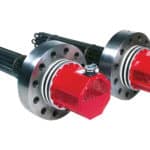There are thousands of craft breweries around the country. California leads the pack with 931. Craft brewing’s younger cousin, home brewing, has never been more popular. The American Home Brewers Association estimates 1.1 million home breweries are operating.
Brewing is an art that requires precision, expertise, and the right equipment. Heating water is the reason we call it “brewing beer.” The brewing immersion heater is one of the most critical components for crafting tasty beer and ales. Whether you’re a novice or a seasoned brewer, selecting the right immersion heater can make all the difference in the quality and consistency of your brew.
With the various options available, it can be overwhelming to determine which heater will suit your needs best. Fortunately for you, our guide will provide all the information about the different types of industrial immersion heaters and the factors to consider when selecting one.
What Is An Immersion Heater?
An immersion heater is an electric metal coil heating element submerged in the liquid to be heated. It connects to an electrical outlet, converting electrical energy into heat energy. The heaters are typically copper or stainless steel heating elements, insulated to prevent electric shock.
Immersion heaters come in many power levels, shapes, and sizes. They heat water and, of course, wort for beer brewing. One of the advantages of immersion heaters is that they are easy to install and operate. For small, hand-held models used in homebrewing, you insert it into the liquid and plug it in.
For larger tanks, immersion heaters will be installed inside the tank, either over the side or through the tank’s wall. A thermostat controls the heating process and regulates the temperature of the liquid.
Bucket heaters are the opposite of immersion heaters. They are flexible heating blankets that wrap around a 5-gallon pail to maintain a maximum temperature of 145°F (62.7°C).
How Does It Work In The Brewing Process?
Several steps in the brewing process require heat. In commercial brewing, there are three separate heating tanks, the mashing tank, lautering tank, and the brewing kettle.
The first step is the malting process or sprouting barley grain. “Steeping” is a process where the brewer immerses the barley in 12°C to 15°C (55°F to 60°F) water for 40 to 50 hours until it germinates. The malted barley mixes with high-temperature water between 62 to 72 °C (144 to 162 °F) in the mashing process. This “Strike Water” extracts the fermentable sugars and starches from the grain.
The resulting liquid, called wort, is filtered into a lautering tank to remove the solid grain. Sparging is a process that rinses the grain with additional hot water to extract any residual starches and sugars.
The wort transfers to the kettle or copper for boiling along with hops and any additional flavoring agents. Boiling stops enzyme activity in the wort and extracts the flavor and bitterness from the hops.
When it comes to brewing, immersion heaters are necessary to ensure that every tank’s liquid reaches the perfect temperature. Consistent temperature affects the final product’s flavor, aroma, and color.
Why Do You Need an Immersion Heater and What Are the Benefits for Your Home Brewery Setup?
Brewing beer requires precise temperature control throughout the process. The immersion heaters allow brewers to achieve and maintain the desired temperature in each tank. After brewing, the beer must be fermented and chilled using fermentation temperature control.
Using an immersion heater for your home brewery setup has several benefits:
Fast heating – Immersion heaters can heat liquids quickly. Rapid heating is critical, as you want the wort to be at the optimal temperature as soon as possible.
Affordable – They are inexpensive and easy to use, making them an excellent option for home brewers just starting out.
Precise temperature control – Immersion heaters control the temperature of the liquid more precisely than other heating methods, such as steam or natural gas.
Convenient and safe – An immersion heater eliminates the task and risk of moving the vessel to and from the heat source. It remains in the tank.
Immersion heaters are also easy to install, operate, and clean. You can start brewing without any hassle.
Factors to Consider When Selecting an Immersion Heater
When selecting an immersion heater for brewing, here are some of the things you should keep in mind:
Watt Density
Watt density refers to the power output applied to the heating element per square inch of surface area. This measurement is a critical factor in immersion heaters, as it affects the performance and lifespan of the heater.
High watt density can lead to the wort scorching and burning, affecting the final product’s flavor and aroma. An element with a low watt density can result in slow heating times and uneven heating.
Use this immersion heater wattage calculator to help find the right heater for your needs. It will determine the watts needed to raise a specific quantity of liquid to an exact temperature in a set time limit.
Sheath Material of The Heating Element
The material surrounding and insulating the actual heating element is the sheath. Quartz, stainless steel, or titanium are common heater sheath materials. However, 304 Stainless steel is the best choice for brewing as it is durable, corrosion-resistant, and easy to clean. Unlike other materials, stainless steel won’t impart any flavor to the brew.
Size and Shape
The size of the heater should be proportional to the size of your brewing vessel. A small heater may not be able to heat a large tank efficiently, while a large heater may be too powerful for a small bucket or tank.
You’ll need to match the shape of the heater to the tank, as it can affect how evenly it distributes the heat. Immersion heater shapes include straight, curved, and L-shaped. A flat, wide heater will heat the liquid more evenly than a narrow, round one.
Additional Features of Immersion Heaters
Some immersion heaters come with digital temperature controllers, which allow you to set and monitor the temperature of the liquid. Others come with safety features such as automatic shut-off and overheating protection.
These features can add to the cost of the heater, but they are worth the expense to ensure the safety and accuracy of your brewing process.
Types of Immersion Heaters
You’ll find several types of immersion heaters suitable for brewing, including:
Screw Plug Immersion Heaters
Screw plug immersion heaters screw into a threaded opening at the bottom of the vessel. They are common in brew kettles and mash tanks. Screw plug heaters are easy to install, remove, and clean, making them convenient for microbrewers.
Flanged Immersion Heaters
Flanged immersion heaters bolt to a flange welded to the tank. Typical sizes range from 3 in. to 14 in., with a watt density of around 45. We find flanged heaters in larger tanks in brewing and industrial applications. Flanged heaters are more difficult to install and remove than screw plug heaters, but they are more secure and durable.
Over-The-Side Immersion Heaters
Over-the-side immersion heaters hang over the tank’s side instead of protruding through it. They can suspend from the top edge of the tank or have feet that keep the heating element off the bottom. Over-the-side heaters are easy to install and a good choice for small brewing setups.
Installation and Maintenance of Immersion heaters
Installing and maintaining an immersion heater is relatively straightforward. Use these tips to ensure that your heater performs optimally:
Installation
- Follow the manufacturer’s instructions for installation.
- Ensure that the heater submerges entirely into the liquid.
- Use the appropriate gasket or seal to prevent leaks.
- Ensure that the heater is adequately grounded to prevent electric shock.
Maintenance
- Inspect the heater regularly for signs of damage or wear.
- Clean the heater regularly to prevent the buildup of sediment or other debris.
- Replace the heater if it shows signs of damage or wear.
Visit Powerblanket for more information about immersion heaters.
Top Immersion Heater Manufacturers In The Market
There are several manufacturers of immersion heaters. Here is a list of the top four producers suitable for the brewing industry:
- Thermon has offices and facilities in the US, Canada, Europe, India, and the UK. Their range of immersion heaters includes flanged, screw plug, over-the-side and bottom-mount immersion heaters, and urn heaters.
- Wattco manufactures its line of immersion heaters in Lachine, Quebec, Canada. They specialize in producing a wide range of heaters, including flange, circulation, and tubular heaters.
- Chromalox provides electric thermal technologies with locations in Utah, Tennessee, Mexico, and China. They have a complete line of immersion heaters and customized process heaters.
- Tempco is based in California and has facilities in Illinois. They specialize in electric heating elements, temperature sensors, power and temperature control products, and over-the-side immersion heaters.
Do You Need a Brew Kettle Immersion Heater?
If you do, get safe, evenly distributed heat for your temperature-sensitive fluids with Powerblanket’s immersion heaters. Explore Immersion Heaters
Happy brewing!
Frequently Asked Questions
How do I know what immersion heater to buy?
To choose the best immersion heater, consider the sheath material suitable for your brewing liquid, ensure the power density matches your heating needs, and select a wattage that efficiently reaches your desired temperature.
Which brand is best for immersion rod?
While specific brands aren't highlighted in our guide, it's crucial to focus on features like durability, safety, and efficiency when selecting an immersion rod for brewing.
Is it worth having an immersion heater?
Yes, an immersion heater is valuable for precise temperature control in brewing, offering a reliable and efficient way to heat liquids without relying on a boiler.
Is it cheaper to leave an electric immersion heater on all the time?
No, it's more cost-effective to use an electric immersion heater only when needed, as continuous operation can lead to unnecessary energy consumption.
Safe, evenly distributed heat for your temperature-sensitive fluids with Powerblanket's Immersion heaters.




